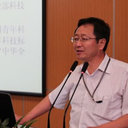Priming of soil carbon decomposition in two Inner Mongolia grassland soils following sheep dung addition: a study using ¹³C natural abundance approach.
キーワード
概要
To investigate the effect of sheep dung on soil carbon (C) sequestration, a 152 days incubation experiment was conducted with soils from two different Inner Mongolian grasslands, i.e. a Leymus chinensis dominated grassland representing the climax community (2.1% organic matter content) and a heavily degraded Artemisia frigida dominated community (1.3% organic matter content). Dung was collected from sheep either fed on L. chinensis (C3 plant with δ¹³C = -26.8‰; dung δ¹³C = -26.2‰) or Cleistogenes squarrosa (C₄ plant with δ¹³C = -14.6‰; dung δ¹³C = -15.7‰). Fresh C₃ and C₄ sheep dung was mixed with the two grassland soils and incubated under controlled conditions for analysis of ¹³C-CO₂ emissions. Soil samples were taken at days 17, 43, 86, 127 and 152 after sheep dung addition to detect the δ¹³C signal in soil and dung components. Analysis revealed that 16.9% and 16.6% of the sheep dung C had decomposed, of which 3.5% and 2.8% was sequestrated in the soils of L. chinensis and A. frigida grasslands, respectively, while the remaining decomposed sheep dung was emitted as CO₂. The cumulative amounts of C respired from dung treated soils during 152 days were 7-8 times higher than in the un-amended controls. In both grassland soils, ca. 60% of the evolved CO₂ originated from the decomposing sheep dung and 40% from the native soil C. Priming effects of soil C decomposition were observed in both soils, i.e. 1.4 g and 1.6 g additional soil C kg⁻¹ dry soil had been emitted as CO₂ for the L. chinensis and A. frigida soils, respectively. Hence, the net C losses from L. chinensis and A. frigida soils were 0.6 g and 0.9 g C kg⁻¹ soil, which was 2.6% and 7.0% of the total C in L. chinensis and A. frigida grasslands soils, respectively. Our results suggest that grazing of degraded Inner Mongolian pastures may cause a net soil C loss due to the positive priming effect, thereby accelerating soil deterioration.


